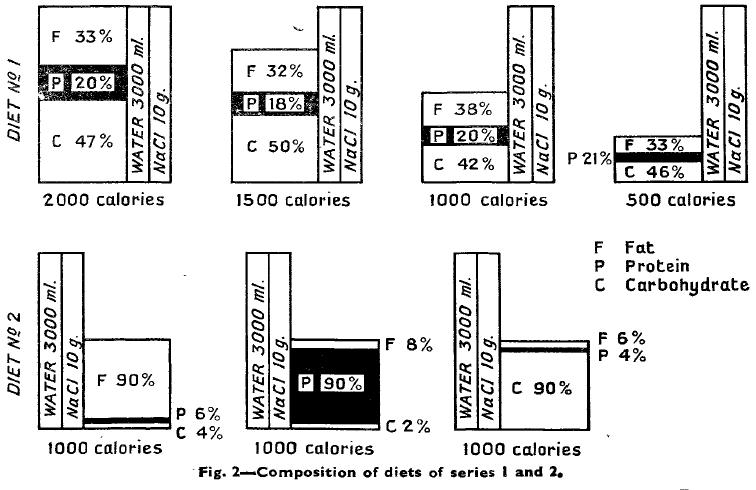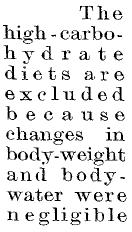80 years later, a calorie still isn’t a calorie.
Exhibit A.
The treatment of obesity (Lyon and Dunlop, 1932)
As early as 1932, Lyon and Dunlop recognized that the calories from as little as one slice of bread every day could result in pounds of fat mass gained every year. For whatever reason, this doesn’t happen to lean people; so they decided to study the effect of different diets on obese subjects in a metabolic ward at the Royal Infirmary.
Their idea of a “diet:”  If they could only see how much times have changed! (this is a hotly debated topic.)
If they could only see how much times have changed! (this is a hotly debated topic.)
Lyon and Dunlop first tested weight loss vs. total calorie intake. The diet was roughly 40% carbs, 24% protein, and 36% fat. Not surprisingly, people fed 800 kcal/d lost more weight than those given 1,000 or 1,200 kcal/d (200 vs. 172 vs. 157 grams of body weight lost per day over the period of 7 – 10 days), confirming that the less you eat, the more weight you lose (duh). A calorie is a calorie after all, right? …
They next tested if all calories were created equal (this is where it starts to get interesting). They found that low carb (40 g/d) with high fat or high protein resulted in the most weight loss (weight loss of 205 and 183 grams per day, respectively). Furthermore, high carb (120 g/d) with low protein or low fat resulted in the least weight loss (122 and 49 grams per day, respectively). Weight loss: LCHF > LCHP > HCLP > HCLF.
They cleverly recognized that water weight could at least partially explain these differences, with which I agree. The other part most likely reflects increased metabolic rate, e.g., by a high protein or high fat diet.
Exhibit B.
24 years later Kekwick and Pawan set out to determine if “a calorie is a calorie” with a battery of different diets, and came to a similar conclusion.
Calorie intake in relation to body-weight changes in the obese (Kekwick and Pawan, 1956)
And I gotta hand it to them for “data presentation” (the late Richard Feynmanwould love it!):
The most dramatic differences in weight loss occurred when their obese subjects were given 90% of calories from either fat, protein, or carbs (the bottom row labeled “DIET No 2” in the chart above).
a three-way cross-over! Well done sirs.
1000 kilocalories are 1000 kilocalories, right? Apparently not; 90% of calories from carbs and weight was maintained.
 (yes, I love the original manuscript.)
(yes, I love the original manuscript.)
Loss of water weight was proportional to the loss of body weight:
 In SERIES 3, the obese subjects were given 2000 kcal high carb, or 2600 kcal high fat:
In SERIES 3, the obese subjects were given 2000 kcal high carb, or 2600 kcal high fat: In each case, more weight was lost on the higher calorie high fat diet relative to the lower calorie high carb diet. More of the weight was water, yes, but not disproportionately so. I reckon the difference was due to the impact of different diets on metabolic rate (i.e., The Laws of Energy Balance -WSL).
In each case, more weight was lost on the higher calorie high fat diet relative to the lower calorie high carb diet. More of the weight was water, yes, but not disproportionately so. I reckon the difference was due to the impact of different diets on metabolic rate (i.e., The Laws of Energy Balance -WSL).
N.B. Case no. 5*, the last row in Table VI (above): They also tested a 2000 kcal high fat diet, which caused almost double the amount of weight loss than the 2600 kcal high fat diet (1.8 vs. 1.0 kg). (support for calorie equality? Perhaps.)
When trying to figure out why weight loss occurred out of proportion to calorie intake, or why all calories aren’t created equal: Strike one. Fecal nitrogen and fat couldn’t explain the differences.
Strike one. Fecal nitrogen and fat couldn’t explain the differences.
Water weight? Strike two. The loss of water weight was directly proportional to weight loss, suggesting a disproportional loss of water on the high fat diets didn’t occur.
Strike two. The loss of water weight was directly proportional to weight loss, suggesting a disproportional loss of water on the high fat diets didn’t occur.
FOR THE WIN:
A calorie is a calorie when macronutrients are kept constant. In the first series of diets (800 vs. 1000 vs. 1200 kcal), lower calories = more weight loss. In case no. 5 of the third series of diets (2600 vs. 2000 kcal of high fat), lower calories = more weight loss.
But a calorie isn’t a calorie when macronutrients are changed. High fat diets consistently caused more weight loss than high carb diets under a wide variety of calorie intakes, even when calories were higher on the high fat diets (series 3).
This isn’t due to water weight, which amounted to roughly 40%, or malabsorption. Food affects metabolic rate, and The Laws of Energy Balance are maintained.









